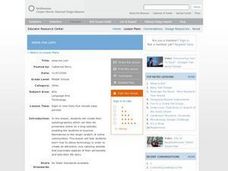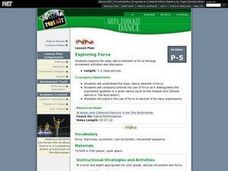Curated OER
Creating AB Patterns
Students work with patterns. In this pattern lesson, students find AB patterns in nature and the manmade world. They create their own AB pattern using math manipulatives and visual arts.
Curated OER
Depression Era Art
Students choose Depression era art to print out from the Internet. They write paragraphs about how the artists interpreted facts about the Depression in their art. The paragraphs and prints can become a student art critic book.
Curated OER
www.Me.Com
Create a graphic autobiography integrating images and text. Working within the structure of the programs Comic Life and Photoshop, pupils integrate the Principles of Design. They focus on balance, rhythm, proportion, and text structure....
Curated OER
Handout #3-Setting Found Poems
What is a Found Poem? Use excerpts of the setting presented in John Steinbeck's Of Mice and Men to inspire Found Poetry. An explanation is given, and the second page houses an example of a Found Poem inspired by Black Boy, but you'll...
Curated OER
Dancing through Poetry
Get your class up and moving as they explore how to express movement and dance through words. Designed around two poems by Lillian Morrison about break dancing, the activity truly captures the creative and multi-sensory aspects of...
Curated OER
A Midsummer Night's Dream Acts 1-2
Blank verse, stichomythia, soliloquy, allusion, oxymoron, malaprop? Readers of A Midsummer Night’s Dream will need to know these terms to successfully complete a study guide designed for the first two acts of Shakespeare’s comedy. The...
Curated OER
Varied Beginnings: Research Process / Narrative Writing Techniques
What's the best way to start a story? Learners write a memoir using effective openings. They research the process and work through a list of hooks to use in their writing. They use at least two hooks to begin their personal memoir. A...
Curated OER
Much Ado About Nothing: Fun Trivia Quiz
Check to see if your pupils can identify characters and basic plot points from Shakespeare's Much Ado About Nothing with this online interactive quiz. While the content is not innovative, this basic quiz could be helpful as a sponge or...
Curated OER
Dig A Little Deeper
Here is a great instructional activity on recognizing events and themes in a story. Learners read chapters from a chosen book and then fill out a graphic organizer to further explore the purpose of the chapter. They write the events,...
Curated OER
Cause and Effect Worksheet 2
Why does Scout fear Boo? Why does George kill Lennie? Whether in literature or life, helping young learners recognize the relationship between actions and consequences is an important lesson. Have your class match twelve observable...
Curated OER
Introduction To Composition And Elements Of Design
High schoolers create a finished drawing with a dynamic, asymmetrical composition. Pencil sketches are encouraged for final projects. Students assess their own work prior to submitting the artwork.
Curated OER
Baseball
In this poetry worksheet, students write a creative poem utilizing each of the first letters in the word baseball on each line and then come up with words that describe baseball using only those letters on each line.
Curated OER
Arts have Emotional Impact
Students explore how various artists use color, line and composition to create a mood. In comparison, students explore various elements of specific art forms that affect the viewer's emotions in dance, theater music and the visual...
Curated OER
Poster Board Lines
Students take notes on line types and directions and then apply that knowledge to create posters depicting the different directions of line. They differentiate between the four different directions of line and the feelings that each...
Curated OER
Line and Shape Game
Students create a picture of an actual scene or overlap the called out lines or shapes into a space-breaker. If someone calls out a line or shape a student had not planned to use in the art, they have to figure out some way to use it...
Curated OER
Narrative Techniques: Plot Lines
Eighth graders develop plot lines as a part of narrative writing process. In this plot lines lesson, 8th graders work in learning groups to create a plot line for a piece of literature they've read. Students discuss the general plot and...
Curated OER
Youth Art Month Pins
Young scholars design and create pins advertising Youth Art Month and incorporating mini versions of famous prints.
Student Achievement Partners
Eleven
Turning 11 comes with a range of emotions. Explore those emotions by reading the short story "Eleven" by Sandra Cisneros. Readers analyze the main character's reactions to the events of her day. Then, they write an essay describing what...
Curated OER
Angling Your Way Through a Picture
Students look at the geometry in an artwork. In this art history/geometry lesson, students research the artist Charles Sheeler and look at his painting Stacks in Celebration. They find the different types of lines, angles, and planes and...
Curated OER
Fused Glass Landscape
Students research and recognize work of several glass artists such as Chihuly, Tiffany, and Wright, define landscape and other relevant vocabulary terms, and create full fused glass plate/bowl using landscape and/or nature as subject...
Curated OER
Monoprint
Students review Gerald Ferstman's work and discuss abstract art. They design and create monoprints on Mylar. They reflect on their work and write about the experience of creating the piece.
Curated OER
Poetry: A Picture of Feelings
Students take a field trip to a place of interest. After the trip they share with a partner their most memorable memory about it. Later, they paint a picture representative of the trip and illustrate it with a poem using at least two...
Curated OER
Exploring Force: The Nutcracker
Students explore basic dance element of force, compare and contrast the use of force as it distinguishes the expressive qualities of a given dance, and explore the use of force in several of its many expressions.
Curated OER
To Freeze or Not to Freeze
Students examine the non-verbal elements of a theatrical performance. They read an article, answer discussion questions, conduct Internet research, and stage frozen tableaux based on lines from Shakespeare's works.

























